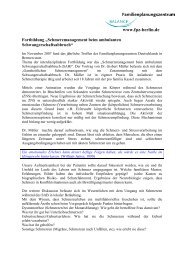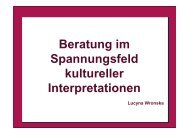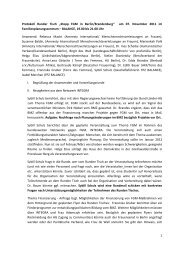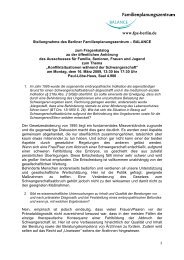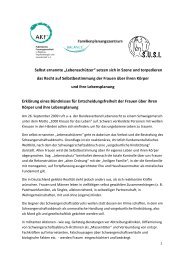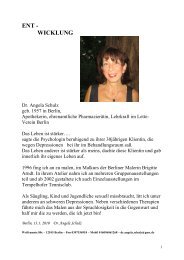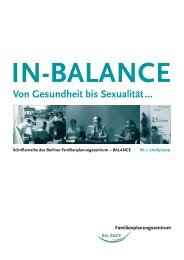that even close friends and people who had trusted them formany years reacted with suspicion and unease during theinterview as is illustrated in the testimony of a participant ofCote d’Ivoire origin:“You are a Muslim like me; you are a Dioula like me. Youare a man of God with good intentions. But the peoplewho receive the data, what are they going <strong>to</strong> do with it?Maybe they will communicate the information <strong>to</strong> the Ausländerbehörde[immigration office] and <strong>to</strong>morrow theywill appear on my doorstep and get me in<strong>to</strong> trouble.”The interviewers also reported that it was nearly impossible<strong>to</strong> mobilise persons living in homes for asylum seekers. Theysometimes spent an entire afternoon in an asylum-seekerhome without being able <strong>to</strong> find a single person willing <strong>to</strong>accept an interview.3.6.4. The nature of the <strong>to</strong>picThe researchers grew accus<strong>to</strong>med <strong>to</strong> introducing the <strong>to</strong>picand creating an environment of trust; nevertheless, itremained challenging for them <strong>to</strong> bring up the <strong>to</strong>pic and <strong>to</strong>make people talk about FGM/C. Even after accepting <strong>to</strong> beinterviewed some people were uncomfortable, ashamed orembarrassed <strong>to</strong> discuss the <strong>to</strong>pic saying that it was tabooand that questions related <strong>to</strong> sexuality could not be debated.Others appeared <strong>to</strong> be withholding information. For womenwho had been subjected <strong>to</strong> the practice, the discussionabout FGM/C sometimes awoke painful memories, forgottenfor many years. The questions put them in a state of sadnessand despair and it was challenging for the interviewers <strong>to</strong>provide emotional support.3.6.5. Negative or highly emotional reactions of participants<strong>to</strong> the research <strong>to</strong>picSome participants became very unfriendly, hostile and aggressivewhen the <strong>to</strong>pic was raised. When informed that theproject was initiated by an international NGO, they statedthings like, “Europeans should mind their own business,” or,“this is an issue for <strong>African</strong>s and not for Germans”. Some accusedthe interviewers of betrayal, of having changed sides.Accusations such as “you work for the Germans now, theyhave bought you <strong>to</strong> help them <strong>to</strong> destroy <strong>African</strong> cultures”or “you should do more honourable work than selling ourculture <strong>to</strong> the Germans” were occasional reactions fromWest <strong>African</strong> participants (Mali, Guinea and Gambia forexample). One woman researcher reported in a meeting:“The man got really angry and started insulting me. He<strong>to</strong>ld me that my grandmother, my mother and I, myself,have been circumcised and that I should not deny ourculture, our identity. He said that I am a bad woman, illrespecting the laws of my own society. I was discouragedafter the interview and unders<strong>to</strong>od that his intention was<strong>to</strong> sabotage me.”3.6.6. Emotional strain for interviewersEvidently, the reactions described in the previous paragraphwere distressing experiences for the interviewers. Beingaccused of betrayal, of disloyalty and of destroying culturalvalues was a highly stressful experience. It created feelingsof discouragement and raised doubts about whetherconducting interviews on FGM/C would lead <strong>to</strong> long-termdisadvantages for them and exclusion from their communities.Furthermore, the suffering of many immigrantsbecame an additional burden for them. Participants used theconversation time <strong>to</strong> share their worries and <strong>to</strong> communicatetheir feelings about the difficulties they were facing asimmigrants in Germany. A Nigerian man, for example, whohas struggled for many years <strong>to</strong> obtain a residence permithad accumulated so much frustration and anger that he <strong>to</strong>ldthe interviewer that his greatest wish had become <strong>to</strong> return<strong>to</strong> Nigeria and <strong>to</strong> become a sniper aiming at killing as manywhite people as possible. The consultations with women stillsuffering from post traumatic reactions related <strong>to</strong> their ownFGM/C were also difficult <strong>to</strong> cope with and exposed theinterviewers <strong>to</strong> a risk of secondary trauma.Other participants used the encounters <strong>to</strong> try <strong>to</strong> chat up thewomen interviewers or <strong>to</strong> embarrass them with anecdotes oftheir sexual experiences or with dirty talk. These situationscame sometimes close <strong>to</strong> sexual harassment and were notalways easy for the researchers <strong>to</strong> handle.3.6.7. Social rejection of interviewersIn addition <strong>to</strong> emotional distress, some interviewers sawthemselves confronted with negative consequences in theirdaily lives. Community members started <strong>to</strong> talk behind theirbacks, <strong>to</strong> avoid them and <strong>to</strong> exclude them from meetings.Whispering started when they entered a public place andpeople s<strong>to</strong>pped greeting them. Some interviewers reportedthat friends had s<strong>to</strong>pped calling and inviting them. A groupof musicians from West Africa, for instance, refused <strong>to</strong> playat a baptism because they did not want <strong>to</strong> do a favour fora person participating in a project against FGM/C. The factthat some interviewers experienced their social supportnetwork weakened can be considered as one of the mostsubstantial difficulties presented by the project.3.6.8. Few possibilities <strong>to</strong> meet immigrants from certaincountriesThe interviewers were not able <strong>to</strong> identify a significantnumber of participants from certain countries. They did not<strong>Listening</strong> <strong>to</strong> <strong>African</strong> <strong>Voices</strong> 19
find, for example, many participants from Liberia, SierraLeone and Guinea Bissau. The identification of persons fromvery small immigrant populations (Sudan, Tanzania, Somalia)also had limited success. At the same time, the proportionsinterviewed from other countries were above 60%. We drewthe conclusion that numerous participants from certain communities(e.g. Guinea or Mali) lived in Hamburg at the timeof the interviews without registration. At the same time, itseemed that members of other communities were registeredin Hamburg, but resided elsewhere.3.6.9. Plan is an unknown organisation <strong>to</strong> migrant communitiesin GermanyMost participants had never heard of Plan and did not havea particular interest in a survey carried out by an institutionthat they were not familiar with and that had no positivereputation for supporting immigrant populations in Germany.3.7. Limits of the study3.7.1. Unique focus on Sub-Saharan AfricaThe study focused exclusively on countries in Sub-SaharanAfrica. Other countries where the practice is known <strong>to</strong> existwere not taken in<strong>to</strong> consideration. We did not include theimmigrant population from Egypt and Yemen in the researcheven though both countries have integrated the issue in thequestionnaire of the Demographic and Health Surveys andhave presented solid estimations for the prevalence ratesof FGM/C in their countries (96% for Egypt and 27% forYemen).The number of registered immigrants from Yemen is verysmall in Hamburg (22 men and seven women). We could notfocus our resources on such a small community. The Egyptiancommunity is more relevant in terms of numbers andthe high prevalence rate in the country. There are officially1249 immigrants of Egyptian origin registered in Hamburg.Most of them are men (857), but among the 392 registeredgirls and women, there are 105 girls below 18 years of age.It is recommended that the further study include or investigatespecifically the knowledge of, attitudes <strong>to</strong>ward andways of practicing FGM/C in the Egyptian immigrant communityin Hamburg.networks (church, mosque, integration classes, communityevents and meetings) or who abstain from visiting typicalmeeting places (Afro shops, main station, betting agencies)were less likely <strong>to</strong> be interviewed. At the same time, personsacquainted with one of the researchers were more likely<strong>to</strong> be interviewed. The snowball sampling and the effortsundertaken <strong>to</strong> collect data from various districts of Hamburgaimed <strong>to</strong> balance this effect. It is clear, however, that theunfeasibility of random sampling reduces the validity of thedata and has <strong>to</strong> be taken in<strong>to</strong> consideration when interpretingthe results.3.7.3. Oral reports as the only sourceThe qualitative and quantitative research <strong>to</strong>ols allowed onlythe collection of data based on oral testimonies. Previousstudies on FGM/C, however, have indicated that verbalreports can be biased. This is usually due <strong>to</strong> efforts ofparticipants <strong>to</strong> provide socially desirable answers (see for exampleCellule de Planification et de Statistique du Ministèrede la Santé, Direction Nationale de la Statistique et del’Informatique du Ministère de l’Économie, de l’Industrie etdu Commerce et al. 2006). It can also be linked <strong>to</strong> the lack ofknowledge. Circumcised women, for example, are sometimesnot aware about the form of FGM/C they have undergoneand give inexact descriptions of what has been done (seefor example Asefaw 2007). Furthermore, some of the studyparticipants feared negative sanctions after respondingtruthfully <strong>to</strong> certain questions. This makes it likely that someof the data collected during the current project is subject <strong>to</strong>reporting bias. We tried <strong>to</strong> mitigate this limitation by takingnote of non-verbal reactions and interview compliance andby excluding dubious responses from the data analysis.3.7.4. Small sample sizes for some countriesThe sample sizes of immigrant populations from Eritrea,Sudan, Tanzania, Somalia, Guinea Bissau, Sierra Leone, andLiberia are <strong>to</strong>o small for an in-depth analysis. For the firstfour countries, the small number of immigrants reachedcan be explained through the small population size of thecommunities in Hamburg. For the three other countries, werecommend further studies <strong>to</strong> gather additional information.3.7.2. No random sampling for the quantitative surveyAs described in section 3.3.2.1, we had no means <strong>to</strong> conducta probability survey for the collection of the quantitativedata. It can be assumed that the probability of gettinginterviewed was not the same for all immigrants fromSub-Saharan Africa. Community members outside social20<strong>Listening</strong> <strong>to</strong> <strong>African</strong> <strong>Voices</strong>






